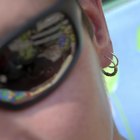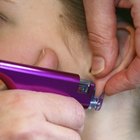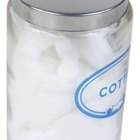
iofoto/iStock/Getty Images
You can schedule a consultation with a professional body piercer to discuss your interest in receiving a piercing. The pain involved with the piercing procedure may be a concern or deciding factor when considering a piercing. During a consultation, a professional body piercer can explain each step of the piercing process to ease any concerns you may have about encountering extreme pain.
Skin Preparation
Before the piercing procedure takes place, your piercer will prepare your skin for the procedure. You will feel no pain while the piercer cleans the area. If the piercer is using a product that results in a burning feeling on your skin, alert the piercer immediately. Most piercers use an antimicrobial soap and gauze to clean the area before piercing, according to Elayne Angel, author of "The Piercing Bible: The Definitive Guide to Safe Body Piercing." If you have sensitive skin and a piercer is using alcohol to prepare the skin for the piercing, you may feel a slight sting.
Marking
After the piercer cleans the area, the piercer marks the location of the piercing with a sterile marking pen or marker. Marking is a painless part of a piercing procedure for most piercings. You may feel a slight pinch, tugging or pulling if you are receiving a tongue piercing. A piercer pulls the tongue upward while marking the placement on the bottom of the tongue and some clients feel mild discomfort.
Piercing
A piercer uses forceps or receiving tube during the piercing as a tool for lining up the marks and holding the skin. You may feel a pinching sensation and pressure when the piercer closes the forceps or inserts the receiving tube, according to Elayne Angel, author of "The Piercing Bible: The Definitive Guide to Safe Body Piercing." When using forceps, the piercer inserts your skin in between the two feet of the forceps and applies pressure to close the forceps. The piercer holds and pushes a receiving tube up against the body part during the piercing. Inexperienced or non-professional piercers may close the forceps too tightly, causing extreme pinching and pain. The resulting piercing and surrounding skin will usually have bruising if this occurs. Forceps and receiving tubes, when placed inside or near your nostril or septum, may cause your eyes to water.
The pain level when the needle enters the skin varies from client to client and from piercing to piercing. For example, due to pain tolerance and endorphins, an industrial piercing may be more painful for one client and relatively painless for the next. A piercer who performs a piercing with professional technique, quickly and with professional needles and equipment is more likely to have clients who will feel the pain involved in a piercing is minimal.
Jewelry Insertion
You will feel minimal pain, similar to a quick pinch, when the piercer inserts the needle and follows the needle with the jewelry. In the event that a novice piercer is attempting to insert jewelry of a larger size than the needle, you may feel a ripping or tearing sensation as the novice forces the jewelry through the small hole. If your piercer inserts externally threaded jewelry into your fresh piercing, you may feel a ripping sensation. Asking your piercer to use internally threaded jewelry for your piercings will prevent the ripping sensation.
Healing
Almost all piercings will swell during the healing period. The skin around your piercing will be sore or tender and fluids will drain out of the piercing and form crusts on your jewelry. During the healing period, if you place pressure on your piercing, such as a telephone on an ear cartilage piercing, your piercing will become irritated, causing more pain than necessary. Touching or turning your jewelry can cause damage to your piercing and cause an infection, while causing you pain when the crusts on the jewelry tear your piercing.
Related Articles

Types of Piercing Needles

Reactions to Nose Piercings

How Is Nipple Piercing Performed?

Places to Pierce Your Ear

How to Remove a Labret Piercing

How to Pierce Your Navel

How to Gauge the Ears Right After the ...

Facts on Nose Piercings

How to Clean Nose Rings

How Do They Pierce Your Ears With ...

What Size Gauge Is an Ear Piercing Gun?

How to Get Rid of a Tattoo Scab

Homemade Recipe to Disinfect a Piercing

How to Care for a Rook Piercing

How to Clean a Tongue Ring

How to Figure Out the Size of Your ...

How to Shave Skin Moles

How to Open Pierced Ears That Have ...

Taking Care of Gauged Ears

Professional Way to Clean an Eyebrow ...
References
Writer Bio
Maude Coffey retired after 10 years working as a professional body modification artist in the tattoo industry. She is certified in principles of infection control and blood-borne pathogens. Coffey received additional training and classes, such as anatomy, jewelry standards and aftercare, from the Association of Professional Piercers. Coffey aims to educate about safe tattooing and piercing practices while writing for various websites.
Photo Credits
iofoto/iStock/Getty Images